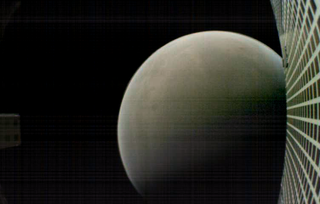The World's 1st Interplanetary Cubesats Go Silent Beyond Mars

The first small spacecraft to ever leave Earth's orbit have been silent for more than a month, NASA said today (Feb. 5) in an announcement about the pair of Mars Cube One (MarCO) probes.
The two MarCO spacecraft (called, specifically, MarCO-A and MarCO-B) launched in May with NASA's InSight lander as a demonstration project. The mission was meant to show that the small satellites that have proliferated over recent years could survive and conduct useful science beyond Earth's immediate neighborhood, and the MarCOs achieved every one of their goals, NASA said.
"This mission was always about pushing the limits of miniaturized technology and seeing just how far it could take us," Andy Klesh, the mission's chief engineer at NASA's Jet Propulsion Laboratory, said in a statement. "We've put a stake in the ground. Future CubeSats might go even farther."
The InSight lander could complete its own mission without its two small companions. But they were designed to relay information about the perilous landing to NASA's engineers faster than other communications systems at Mars could do.
And within just minutes of the scheduled touchdown on Nov. 26, the MarCO satellites sent home word that InSight had safely landed. One of the cubesats, MarCO-B, also captured incredible pictures of Mars itself as the tiny pair flew by the planet.
The $18.5 million mission met all its goals on landing day, even as the spacecraft themselves barreled past Mars. They also captured hearts on their daring adventure, with MarCO-A nicknamed EVE and its partner called WALL-E, in honor of characters in the animated film "WALL-E."
NASA estimates that MarCO-A, which last phoned home on Jan. 4, is now nearly 2 million miles (3.2 million kilometers) beyond Mars. MarCO-B, which has been silent since Dec. 29, has traveled about half that distance past the planet.
Get the Space.com Newsletter
Breaking space news, the latest updates on rocket launches, skywatching events and more!
Plenty of threats could have felled the two interplanetary spacecraft for good, but just in case they're still out there, NASA will ping the cubesats again in the summer, when their orbits carry the MarCOs closer to Earth.
And in the meantime, NASA has plenty of plans to design additional small spacecraft, building on the legacy of the first interplanetary cubesats.
Email Meghan Bartels at mbartels@space.com or follow her @meghanbartels. Follow us @Spacedotcom and Facebook. Original article on Space.com.
Join our Space Forums to keep talking space on the latest missions, night sky and more! And if you have a news tip, correction or comment, let us know at: community@space.com.

Meghan is a senior writer at Space.com and has more than five years' experience as a science journalist based in New York City. She joined Space.com in July 2018, with previous writing published in outlets including Newsweek and Audubon. Meghan earned an MA in science journalism from New York University and a BA in classics from Georgetown University, and in her free time she enjoys reading and visiting museums. Follow her on Twitter at @meghanbartels.
